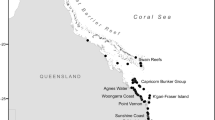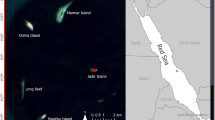Abstract
During 1955–2003, flipper tags were attached to 46,983 green turtles and ten turtles were fitted with satellite transmitters at Tortuguero, Costa Rica. Eight satellite-tracked turtles stayed within 135 km of the beach and probably returned to nest after release. The internesting area is more extensive than previously documented. Post-nesting migration routes of satellite-tracked turtles varied. Seven turtles swam close to the coast and three turtles swam through oceanic waters before moving toward nearshore areas. Sea surface height anomaly maps indicate that oceanic movements were consistent with the southwestern Caribbean gyre. Circling and semi-circling turtles could have been disoriented but submergence and surface times suggest they may have been feeding in Sargassum sp. concentrations. Rapid post-nesting migrations (mean 2.2 km hr−1) ended on benthic feeding grounds in shallow waters (<20 m) off Belize (n=1), Honduras (n=1) and Nicaragua (n=8). The spatial distribution of migration end points (n=10) and tag returns (n=4,669) are similar. Fishermen in Nicaragua target green turtles along migratory corridors and on foraging grounds. Management efforts are urgently needed in Nicaragua, particularly in the high-density feeding areas south and east of the Witties (N14°09 W82°45). The proximity of foraging grounds to the nesting beach (mean 512 km) may permit female turtles to invest more energy in reproduction and hence the Tortuguero population may have greater potential for recovery than other green turtle nesting populations. Recovery of the Tortuguero green turtle population will benefit countries and marine ecosystems throughout the Caribbean, especially Nicaragua.








Similar content being viewed by others
References
Addison DS, Gore JA, Ryder J, Worley K (2002) Tracking post-nesting movements of loggerhead turtles (Caretta caretta) with sonic and radio telemetry on the southwest coast of Florida, USA. Mar Biol 141:201–205
Andrade CA, Barton ED, Mooers CNK (2003) Evidence for an eastward flow along the central and south American Caribbean coast. J Geophys Res 108:16-1–16-11
Balazs GH (1994) Homeward bound: satellite tracking of Hawaiian green turtles from nesting beaches to foraging pastures. In: Schroeder BA, Witherington BE (eds) Proceedings of the 13th annual symposium on sea turtle biology and conservation. US Dep. Commer. NOAA Tech Memo NMFS-SEFSC-341:205–208
Balazs GH (1999) Factors to consider in the tagging of sea turtles. In: Eckert KL, Bjorndal KA, Abreu-Grobois FA, Donnelly M (eds) Research and management techniques for the conservation of sea turtles. IUCN/SSC marine turtle specialist group Publication No 4:101–109
Balazs GH, Miya RK, Beaver SC (1996) Procedures to attach a satellite transmitter to the carapace of an adult green turtle, Chelonia mydas. In: Keinath JA, Barnard DE, Musick JA, Bell BA (Compilers) Proceedings of the 15th annual symposium on sea turtle biology and conservation. US Dep. Commer. NOAA Tech Memo NMFS-SEFSC-37:21–26
Bellini C, Godfrey MH, Sanches TM (2001) Metal tag loss in wild juvenile hawksbill sea turtles (Eretmochelys imbricata). Herp Rev 32:172–174
Bentivegna F (2002) Intra-Mediterranean migrations of loggerhead sea turtles (Caretta caretta) monitored by satellite telemetry. Mar Biol 141:795–800
Bjorndal KA (1995) The consequences of herbivory for the life history pattern of the Caribbean green turtle, Chelonia mydas. In: Bjorndal KA (ed) Biology and conservation of sea turtles revised edition. Smithsonian Institution, Washington, pp 111–116
Bjorndal KA (1997) Foraging ecology and nutrition of sea turtles. In: Lutz PL, Musick JA (eds) The biology of sea turtles. CRC, Boca Raton, pp 199–231
Bjorndal KA, Jackson JBC (2003) Roles of sea turtles in marine ecosystems: Reconstructing the past. In: Lutz PL, Musick JA, Wyneken J (eds) The biology of sea turtles Volume II. CRC, Boca Raton, pp 259–273
Bjorndal KA, Wetherall JA, Bolten AB, Mortimer JA (1999) Twenty-six years of green turtle nesting at Tortuguero, Costa Rica: An encouraging trend. Conserv Biol 13(1):126–134
Bjorndal KA, Bolten AB, Chaloupka MY (2000) Green turtle somatic growth model: evidence for density dependence. Ecol Appl 10(1):269–282
Bjorndal KA, Bolten AB, Chaloupka MY (2003) Survival probability estimates for immature green turtles Chelonia mydas in the Bahamas. Mar Ecol Prog Ser 252:273–281
Bouchard SS, Bjorndal KA (2000) Sea turtles as biological transporters of nutrients and energy from marine to terrestrial ecosystems. Ecology 81(8):2305–2313
Campbell CL (2003) Population assessment and management needs of a green turtle, Chelonia mydas, population in the western Caribbean. PhD dissertation, University of Florida, Gainesville
Campbell CL, Lagueux CJ (2005) Survival probability estimates for large juvenile and adult green turtles (Chelonia mydas) exposed to an artisanal marine turtle fishery in the western Caribbean. Herpetologica 61(2):91–103
Carr A (1987a) New perspectives on the pelagic stage of sea turtle development. Conserv Biol 1(2):103–121
Carr A (1987b) Impact of nondegradable marine debris on the ecology and survival outlook of sea turtles. Mar Pollut Bull 18:352–356
Carr A, Giovannoli L (1957) The ecology and migrations of sea turtles. 2. Results of field work in Costa Rica, 1955. Am Mus Novit 183:1–32
Carr A, Meylan AB (1980) Evidence of passive migration of green turtle hatchlings in sargassum. Copeia 1980(2):366–368
Carr A, Carr MH, Meylan AB (1978) The ecology and migrations of sea turtles, 7. The west Caribbean green turtle colony. Bull Am Mus Nat Hist 162:1–46
Chaloupka M (2002) Stochastic simulation modelling of southern Great Barrier Reef green turtle population dynamics. Ecol Modell 148:79–109
Cheng IJ (2000) Post-nesting migrations of green turtles (Chelonia mydas) at Wan-An Island, Penghu Archipelago, Taiwan. Mar Biol 137:747–754
Creed JC, Phillips RC, Van Tussenbroek BI (2003) The seagrasses of the Caribbean. In: Green EP, Short FT (eds) World atlas of seagrasses. University of California, Berkeley, pp 234–242
Godley BC, Richardson S, Broderick AC, Coyne MS, Glen F, Hays GC (2002) Long-term satellite telemetry of the movements and habitat utilisation by green turtles in the Mediterranean. Ecography 25:352–362
Green EP, Short FT (2003) World atlas of seagrasses. University of California, Berkeley
Hays GC, Puschi P, Papi F, del Seppia C, Marsh R (1999) Changes in behavior during the inter-nesting migration for Ascension Island green turtles. Mar Ecol Prog Ser 189:263–273
Hays GC, Å kesson S, Broderick AC, Glen F, Godley BJ, Luschi P, Martin C, Metcalfe JD, Papi F (2001a) The diving behavior of green turtles undertaking oceanic migration to and from Ascension Island: dive durations, dive profiles and depth distribution. J Exp Biol 204:4093–4098
Hays GC, Dray M, Quaife T, Smyth TJ, Mironnet NC, Luschi P, Papi F, Barnsley MJ (2001b) Movements of migrating green turtles in relation to AVHRR derived sea surface temperature. Int J Remote Sens 22(8):1403–1411
Hays GC, Å kesson S, Godley BJ, Luschi P, Santidrian P (2001c) The implications of location accuracy for the interpretation of satellite-tracking data. Anim Behav 61:1035–1040
Hays GC, Broderick AC, Godley BJ, Lovell P, Martin C, McConnell BJ, Richardson S (2002a). Biphasal long-distance migration in green turtles. Anim Behav 64:895–898
Hays GC, Glen F, Broderick AC, Godley BJ, Metcalfe JD (2002b) Behavioral plasticity in a large marine herbivore: contrasting patterns of depth utilisation between two green turtles (Chelonia mydas) populations. Mar Biol 141:985–990
Hendrickson JR (1958) The green sea turtle, Chelonia mydas (Linn.) in Malaya and Sarawak. Proc Zool Soc Lond 130(4):455–535
Hirth HF (1997) Synopsis of the biological data on the green turtle Chelonia mydas (Linnaeus 1758). USFWS Biological Report 97(1)
Jackson JBC (1997) Reefs since Columbus. Coral Reefs 16(Suppl):S23–S32
Jackson JBC, Kirby MX, Berger WG, Bjorndal KA, Botsford LW, Bourque BJ, Bradbury RH, Cooke R, Erlandson J, Estes JA, Hughes TP, Kidwell S, Lange CB, Lenihan HS, Pandolfi JM, Peterson CH, Steneck RS, Tegner MJ, Warner RR (2001) Historical overfishing and the recent collapse of coastal ecosystems. Science 293:629–638
Lagueux CJ (1998) Marine turtle fishery of Caribbean Nicaragua: human use patterns and harvest trends. PhD dissertation, University of Florida, Gainesville
Lima EHSM, Troëng S (2001) Link between green turtles foraging in Brazil and nesting in Costa Rica? Mar Turtle News 94:9
Luschi P, Hays GC, Del Seppia C, Marsh R, Papi F (1998) The navigational feats of green sea turtles migrating from Ascension Island investigated by satellite telemetry. Proc R Soc Lond B Biol Sci 265:2279–2284
Luschi P, Å kesson S, Broderick AC, Glen F, Godley BJ, Papi F, Hays GC (2001) Testing the navigational abilities of ocean migrants: displacement experiments on green sea turtles (Chelonia mydas). Behav Ecol Sociobiol 50:528–534
Luschi P, Hays GC, Papi F (2003a) A review of long-distance movements by marine turtles, and the possible role of ocean currents. Oikos 103:293–302
Luschi P, Sale A, Mencacci R, Hughes GR, Lutjeharms JRE, Papi F (2003b) Current transport of leatherback sea turtles (Dermochelys coriacea) in the ocean. Proc R Soc Lond B Biol Sci 270(Suppl):S129–S132
Lutcavage ME, Plotkin P, Witherington B, Lutz PL (1997) Human impacts on sea turtle survival. In: Lutz PL, Musick JA (eds) The biology of sea turtles. CRC, Boca Raton, pp 387–409
McCauley SJ, Bjorndal KA (1999) Conservation implications of dietary dilution from debris ingestion: sublethal effects in post-hatchling loggerhead sea turtles. Conserv Biol 13(4):925–929
Meylan AB (1995) Behavioral ecology of the west Caribbean green turtle (Chelonia mydas) in the internesting habitat. In: Bjorndal KA (ed) Biology and conservation of sea turtles revised edition. Smithsonian Institution, Washington DC, pp 67–80
Morreale SJ, Standora EA, Spotila JR, Palandino FV (1996) Migration corridor for sea turtles. Nature 384:319–320
Mortimer JA (1981) The feeding ecology of the west Caribbean green turtle (Chelonia mydas) in Nicaragua. Biotropica 13(1):49–58
Papi F, Luschi P (1996) Pinpointing ‘Isla Meta’: the case of sea turtles and albatrosses. J Exp Biol 199:65–71
Polovina JJ, Kobayashi DR, Parker DM, Seki MP, Balazs GH (2000) Turtles on the edge: movement of loggerhead turtles (Caretta caretta) along oceanic fronts, spanning longline fishing grounds in the central North Pacific, 1997–1998. Fish Oceanogr 9:71–82
Pritchard P (1973) International migrations of South American sea turtles (Cheloniidae and Dermochelidae). Anim Behav 21:18–27
Seminoff J (2004) Marine turtle specialist group Chelonia mydas assessment. IUCN Marine Turtle Specialist Group, pp 34
Seminoff JA, Resendiz A, Nichols WJ (2002) Home range of green turtles Chelonia mydas at a coastal foraging area in the Gulf of California, Mexico. Mar Ecol Prog Ser 242:253–265
Sheng J, Tang L (2003) A numerical study of circulation in the Western Caribbean Sea. J Phys Oceanogr 33:2049–2069
Solow AR, Bjorndal KA, Bolten AB (2002) Annual variation in nesting numbers of marine turtles: the effect of sea surface temperature on remigration intervals. Ecol Lett 5:742–746
Troëng S, Drews C (2004) Money talks: economic aspects of marine turtle use and conservation. WWF-International, Gland, Switzerland
Troëng S, Rankin E (2005) Long-term conservation of the green turtle Chelonia mydas nesting population at Tortuguero, Costa Rica. Biol Conserv 121:111–116
Troëng S, Mangel J, Reyes C (2003) Comparison of monel#49 and inconel#681 tag loss in green turtles Chelonia mydas nesting at Tortuguero, Costa Rica. Proceedings of the twenty-second annual symposium on sea turtle biology and conservation. U.S. Dep. Commer. NOAA Tech Memo NMFS-SEFSC-503:121–122
Acknowledgments
Two anonymous reviewers provided feedback that greatly improved this contribution. Funding for the project was provided by the US NOAA/National Marine Fisheries Service, Shark Reef Aquarium at Mandalay Bay, Volvo Ocean Adventure, the Rotterdam Zoo and additional funding for the Sea Turtle Migration-Tracking Education Program (http://www.cccturtle.org) has been provided by the Disney Wildlife Conservation Fund, Educational Foundation of America and the Kenneth A. Scott Charitable Trust (A Key Bank Trust). ESRI kindly provided ArcView software at a discounted cost. Barbara Schroeder and George Balazs provided invaluable technical advice that made this study possible. Jeff Mangel, Catalina Reyes and numerous research assistants with the CCC’s Green Turtle Program are acknowledged for assisting in the attachment of satellite transmitters and flipper tags. Helen Fazakerly provided useful insights into epiphytic communities associated with Sargassum sp. Tag recapture information was provided by fishers and other observers. Peter Eliazar’s (ACCSTR) facilitation of tag information deserves special mention. This study was conducted under a research permit issued by the MINAE of Costa Rica and complied with all relevant national legislation.
Author information
Authors and Affiliations
Corresponding author
Additional information
Communicated by P.W. Sammarco, Chauvin
Rights and permissions
About this article
Cite this article
Troëng, S., Evans, D.R., Harrison, E. et al. Migration of green turtles Chelonia mydas from Tortuguero, Costa Rica. Marine Biology 148, 435–447 (2005). https://doi.org/10.1007/s00227-005-0076-4
Received:
Accepted:
Published:
Issue Date:
DOI: https://doi.org/10.1007/s00227-005-0076-4




